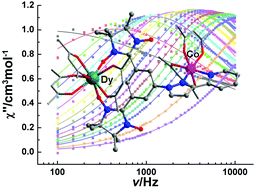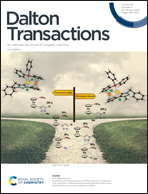Slow magnetic relaxation in CoII–LnIII heterodinuclear complexes achieved through a functionalized nitronyl nitroxide biradical†
Abstract
A new nitronyl nitroxide biradical ligand NITPh-PyPzbis (5-(3-(2-pyridinyl)-1H-pyrazol-1-yl)-1,3-bis(1′-oxyl-3′-oxido-4′,4′,5′,5′-tetramethyl-4,5-hydro-1H-imidazol-2-yl)benzene) has been successfully applied for constructing a 3d–4f CoII–LnIII system, giving rise to a family of novel hetero-tri-spin complexes, namely, [LnCo(hfac)5(NITPh-PyPzbis)]·CH2Cl2 (LnCo = YCo 1, GdCo 2, TbCo 3, DyCo 4, and HoCo 5; hfac = hexafluoroacetylacetonate). In these hetero-tri-spin complexes, the NITPh-PyPzbis biradical chelates one LnIII and one CoII simultaneously by means of its adjacent aminoxyl moieties and two N donors from the 3-(2-pyridinyl)-1H-pyrazol-1-yl unit, respectively, realizing the unique biradical-Co–Ln heterodinuclear structure. Direct-current magnetic susceptibility investigations show that antiferromagnetic coupling is predominant in the YCo derivative, while the leading magnetic interaction in the GdCo analogue is ferromagnetic. Alternating-current data for the DyCo complex display visible temperature/frequency-dependent χ′′ peaks, indicating the SMM behavior. In the fluorescence spectra, four characteristic emission bands of the TbIII ion have been detected for the TbCo analogue.



 Please wait while we load your content...
Please wait while we load your content...